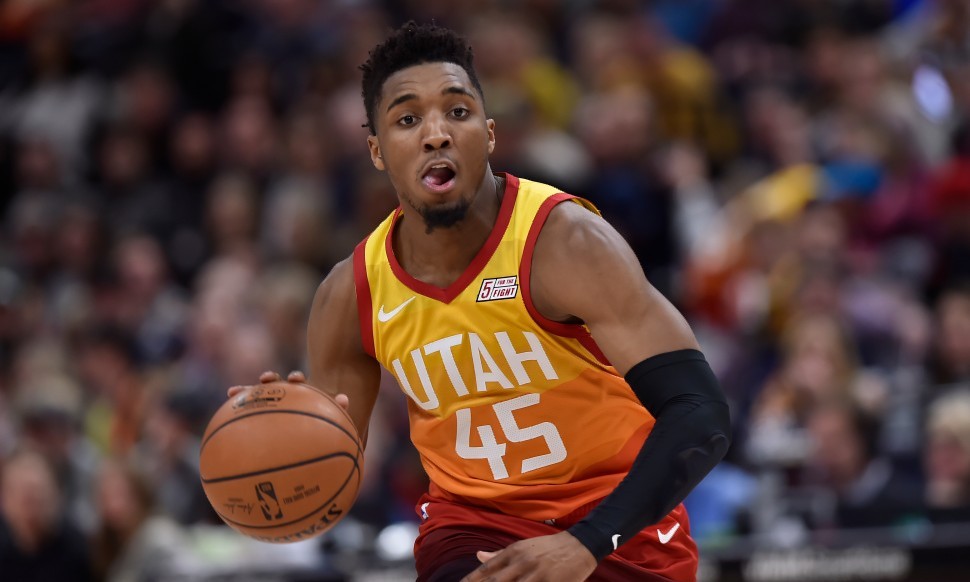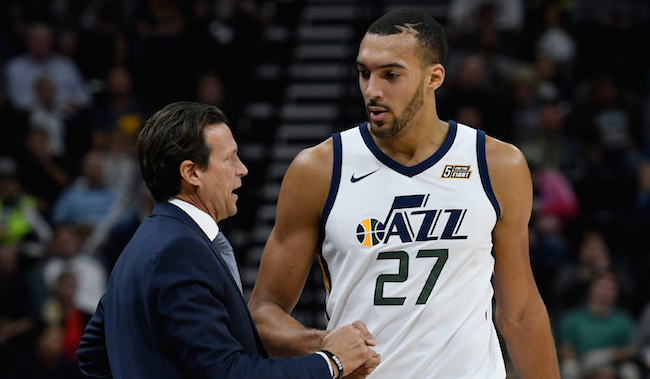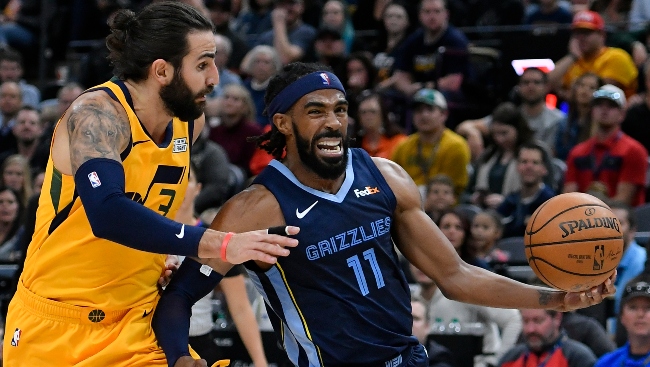The Utah Jazz enter the 2019-20 season with lofty expectations, with a projected win total at 54.5 at Westgate, which is tied with the Clippers and Rockets for the top spot in the Western Conference.
Utah being a legitimate title contender this season is rather stunning when you consider where they were two summers ago, watching their star player, Gordon Hayward, choose the Boston Celtics over staying in Salt Lake in free agency. In the immediate aftermath, the expectation was that a rather hefty rebuild would need to take place in Utah despite having made a playoff run to the second round the year before.
Teams in smaller markets don’t often have the luxury of simply reloading when their top player leaves town, and Utah, while a team that seemed to be heading in the right direction, wasn’t exactly a roster that seemed loaded and poised for a run in the near future. What has transpired over the last two years has been nothing short of remarkable in Utah, as the Jazz have done a tremendous job of identifying and developing talent to build one of the league’s deepest and best rosters, one expected to find itself near the top of the West even as superstars have teamed up around them. They’ve done so via internal development, savvy free agency moves and trades, and, of course, one very significant draft steal.

Landing Donovan Mitchell in a draft night trade with the Nuggets will always be considered the most important moment for the Jazz in keeping their upward trajectory despite Hayward’s departure later that summer. As with all draft success stories, there is significant luck involved in Mitchell being what he was immediately as a rookie, but Utah moving the 24th pick and Trey Lyles to Denver to bring in a dynamic guard who could have paired with Hayward but also served as an insurance policy if he left turned out to be brilliant.
Mitchell wasn’t supposed to be a Rookie of the Year candidate given that he went in the late lottery, but his abilities as a scorer allowed Utah to move on from Hayward’s presence without missing a beat. The Jazz were expected to struggle to find that first-option on offense without Hayward, especially after swapping George Hill out for Ricky Rubio in free agency, but Mitchell stepped in and took on that role with great aplomb. While not always the most efficient, his playmaking abilities have been, at times, heroic in helping to carry the Jazz offense and even with a bit of a sophomore slump he’s among the league’s best young guards.
The now third-year guard out of Louisville is the lead example of the success of Utah’s player development program, which has to be on the short list of the best in the league after what they’ve done over the past few years. Quin Snyder, once the headmaster of Hawks University that churned out over-producing wings in Atlanta, and his development staff have done a spectacular job with the likes of Mitchell and others. Not every young player that’s come in contact with this staff has become a star and there have been some that have simply not panned out with Utah. Alec Burks and Rodney Hood were expected to be two of the bright spots in the post-Hayward era, but neither could find their footing with the Jazz and were eventually traded away. Dante Exum remains a work in progress, in large part due to injury woes, and has not yet fulfilled his potential as a one-time Summer League darling.
However, the success rate in Utah of tapping into player potential has been astounding, and is a credit to the staff and players alike — it should always be mentioned that player development can only go so far as the players in the program are willing to go.

Rudy Gobert’s evolution into a star has been as important as that of Mitchell to the Jazz’s recent success. Long a preternatural talent on the defensive end, Gobert has reached his full potential on that end (which does not always happen) to become the reigning two-time Defensive Player of the Year. He anchors Utah’s defense which consistently lands near the top of the league in defensive efficiency, but it’s what he’s done to improve his offensive game that’s maybe most impressive. He’s not a dynamic offensive playmaker, but doesn’t have to be. They simply needed him to be better on the block and a more capable rim-runner both in pick-and-rolls and working towards the basket from the weak side. He’s done that and become one of the league’s most efficient big men at the same time that he’s increased his raw productivity on that end, all while lording over the paint on the other end.
Joe Ingles has likewise taken full advantage of the Jazz’s development program. In Hayward’s last year, Ingles averaged 7.1 points per game and was, simply, a catch-and-shoot player. The Australian sharpshooter has always had ability from distance, but it’s his improvement in other areas that’s allowed him to become a starter on a playoff squad in Hayward’s stead. Ingles has taken on more of a playmaking role in recent years as evidenced by 5.7 assists per game last year, all while continuing to be one of the league’s best marksmen. He’s also evolved into a solid defender within Utah’s system, which allows him to log north of 31 minutes per game on one of the league’s best defensive units.
That trio becoming the core of one of the league’s best teams is something no one could have foreseen in the summer of 2017, but they are far from alone. The Jazz have identified veteran talent that fits their needs and their culture tremendously well since Hayward’s departure, and managed to maintain a strong identity despite some significant roster turnover, thanks in large part to that strong core.
Ricky Rubio was the right point guard at the right time for the Jazz, as he was a steady hand next to Mitchell who also didn’t obstruct the rapid development of Mitchell into a leading man on offense. He fit their defensive needs and while never a dynamic scorer, opened up the floor with his passing and had bursts (particularly in 17-18) of quality shooting. After two years of Rubio, which allowed Mitchell the opportunities to become what he has, they brought in Mike Conley via trade this summer which should be an upgrade on the offensive end without giving up too much defensively. Conley comes from a Memphis organization that, at its peak, had a similar ethos to this Jazz team, and can help take some of the pressure off of Mitchell offensively, who now can hopefully increase his efficiency.

On the wing they’ve had Jae Crowder, Kyle Korver, and Thabo Sefolosha all rotate in behind Ingles to varying success, but all played their role (when healthy). With the emergence of Royce O’Neale, another product of their internal development, the Jazz have moved on from those veterans and spent a significant portion of their cap space on Bojan Bogdanovic, another player that figures to help immensely on the offensive end and comes from another team in Indiana that has a similar mindset and culture to that in Indiana.
In the frontcourt, Derrick Favors was the most tenured member of the Jazz, having been in Utah since the 2010-11 trade deadline. He was the player that took the biggest step back in role among the key players in the post-Hayward era, ceding some of his opportunities to Gobert and others. Favors was reliable and while never a perfect fit with Gobert, was a steady presence and always capable offensive player down low. He was sent to New Orleans this year to help clear cap space to bring in Bogdanovic, as Utah will likely trot out smaller lineups around Gobert this coming season. In his stead, they landed the perpetually underrated Ed Davis in free agency, who can anchor a second unit defensively and provide some insurance should Gobert miss any time. While not Favors, the offensive additions elsewhere that will take them more towards small ball made it more imperative to find some frontcourt defensive help behind Gobert.
The moves the Jazz made this summer seemed to be with two things in mind. The first is to upgrade their biggest weakness, which was a lack of offensive playmakers. The second was to ensure that the players they brought in to improve that offense would still fit with the culture they’ve created which so heavily relies on a strong defensive identity, as evidenced by targeting players from Memphis, Indiana, and Brooklyn.
It will be a bit strange to see a Jazz team with this much offensive potency, as they have the chance to trot out some truly terrifying offensive lineups around Gobert as the steady anchor on defense. Whatever step back they may take defensively should be outweighed by a pretty tremendous leap forward offensively.
Utah wasn’t among the teams to create a new dynamic duo, but still managed to have one of the most impressive offseasons in the NBA. To do so two years removed from what many thought was a disastrous, franchise-altering summer in which they saw their biggest star walk away is remarkable.







